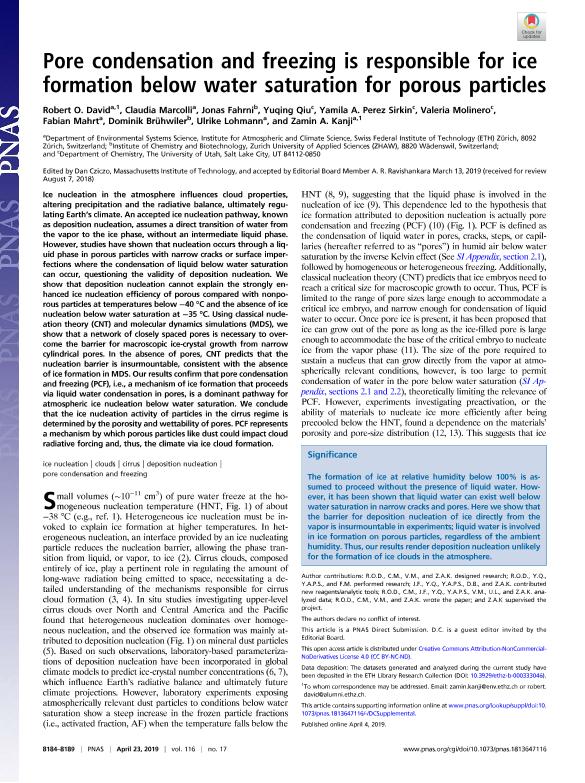Artículo
Pore condensation and freezing is responsible for ice formation below water saturation for porous particles
David, Robert O.; Marcolli, Claudia; Fahrni, Jonas; Qiu, Yuqing; Pérez Sirkin, Yamila Anahí ; Molinero, Valeria; Mahrt, Fabian; Brühwiler, Dominik; Lohmann, Ulrike; Kanji, Zamin A.
; Molinero, Valeria; Mahrt, Fabian; Brühwiler, Dominik; Lohmann, Ulrike; Kanji, Zamin A.
 ; Molinero, Valeria; Mahrt, Fabian; Brühwiler, Dominik; Lohmann, Ulrike; Kanji, Zamin A.
; Molinero, Valeria; Mahrt, Fabian; Brühwiler, Dominik; Lohmann, Ulrike; Kanji, Zamin A.
Fecha de publicación:
04/2019
Editorial:
National Academy of Sciences
Revista:
Proceedings of the National Academy of Sciences of The United States of America
ISSN:
0027-8424
Idioma:
Inglés
Tipo de recurso:
Artículo publicado
Clasificación temática:
Resumen
Ice nucleation in the atmosphere influences cloud properties, altering precipitation and the radiative balance, ultimately regulating Earth’s climate. An accepted ice nucleation pathway, known as deposition nucleation, assumes a direct transition of water from the vapor to the ice phase, without an intermediate liquid phase. However, studies have shown that nucleation occurs through a liquid phase in porous particles with narrow cracks or surface imperfections where the condensation of liquid below water saturation can occur, questioning the validity of deposition nucleation. We show that deposition nucleation cannot explain the strongly enhanced ice nucleation efficiency of porous compared with nonporous particles at temperatures below −40 °C and the absence of ice nucleation below water saturation at −35 °C. Using classical nucleation theory (CNT) and molecular dynamics simulations (MDS), we show that a network of closely spaced pores is necessary to overcome the barrier for macroscopic ice-crystal growth from narrow cylindrical pores. In the absence of pores, CNT predicts that the nucleation barrier is insurmountable, consistent with the absence of ice formation in MDS. Our results confirm that pore condensation and freezing (PCF), i.e., a mechanism of ice formation that proceeds via liquid water condensation in pores, is a dominant pathway for atmospheric ice nucleation below water saturation. We conclude that the ice nucleation activity of particles in the cirrus regime is determined by the porosity and wettability of pores. PCF represents a mechanism by which porous particles like dust could impact cloud radiative forcing and, thus, the climate via ice cloud formation.
Archivos asociados
Licencia
Identificadores
Colecciones
Articulos(INQUIMAE)
Articulos de INST.D/QUIM FIS D/L MATERIALES MEDIOAMB Y ENERGIA
Articulos de INST.D/QUIM FIS D/L MATERIALES MEDIOAMB Y ENERGIA
Citación
David, Robert O.; Marcolli, Claudia; Fahrni, Jonas; Qiu, Yuqing; Pérez Sirkin, Yamila Anahí; et al.; Pore condensation and freezing is responsible for ice formation below water saturation for porous particles; National Academy of Sciences; Proceedings of the National Academy of Sciences of The United States of America; 116; 17; 4-2019; 8184-8189
Compartir
Altmétricas



